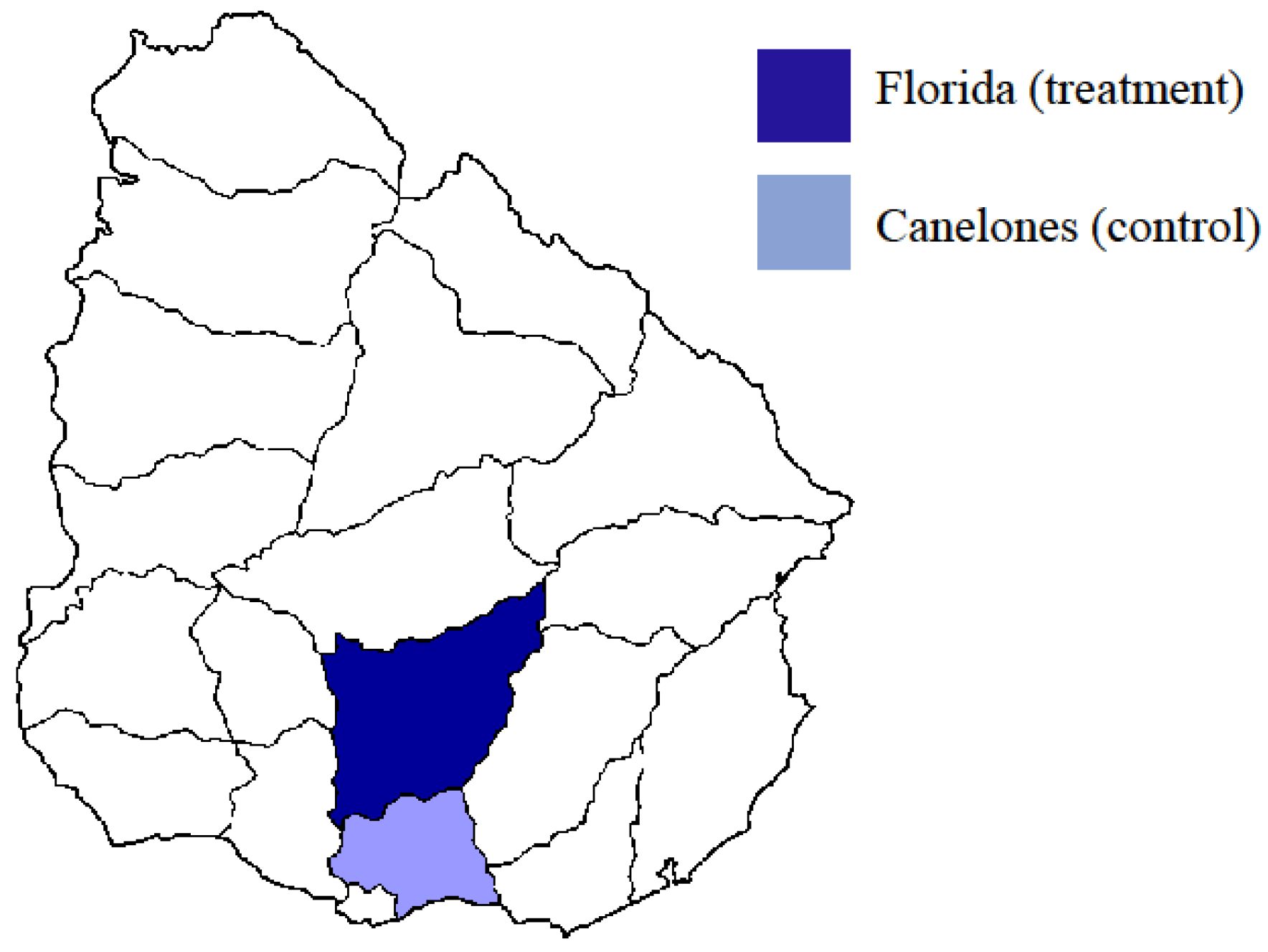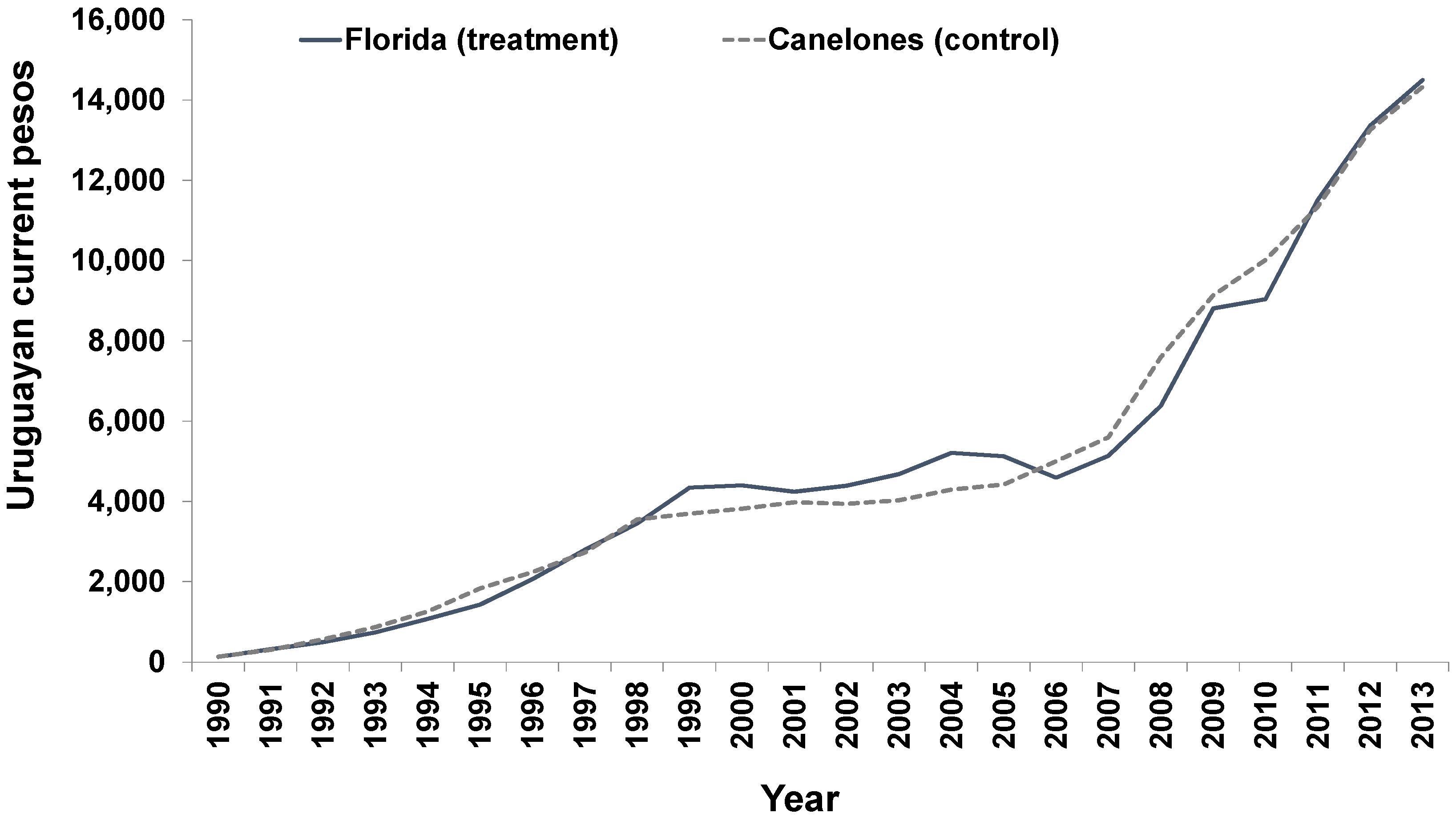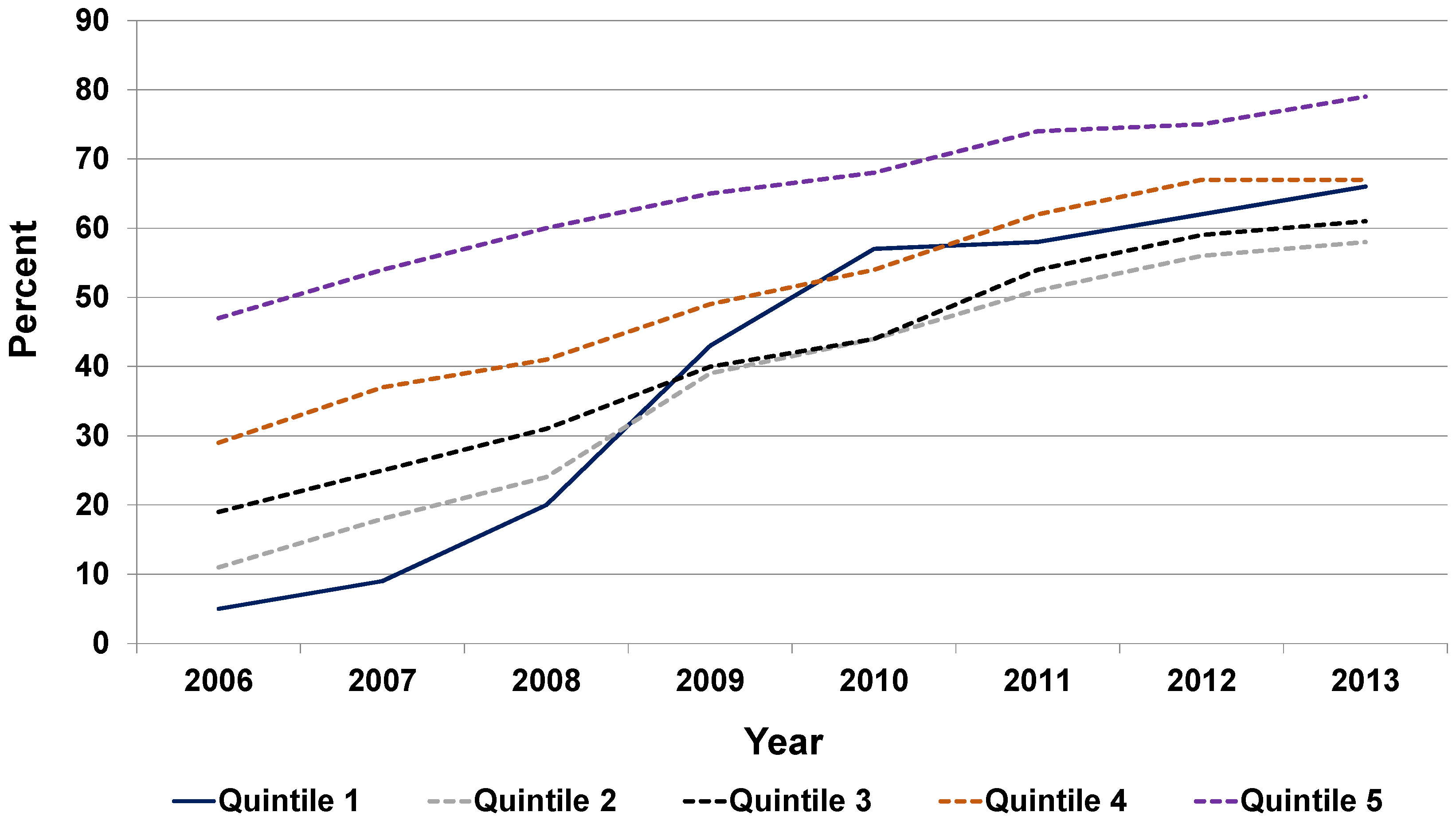The Effect of Access to Information and Communication Technology on Household Labor Income: Evidence from One Laptop Per Child in Uruguay
Abstract
:1. Introduction
2. Background
3. Methodology and Empirical Framework
4. Conclusions and Policy Implications
Acknowledgments
Author contributions
Conflicts of Interest
Appendix A. Variables Definitions and Data Sources
Appendix B
| Dependent Variable: Log of Total Real Labor Income | q40 | q60 | q80 | ||||||
|---|---|---|---|---|---|---|---|---|---|
| Independent Variables | Coeff. | SE | Coeff. | SE | Coeff. | SE | |||
| F (Treatment) | −0.08 | 0.08 | 0.04 | 0.08 | 0.03 | 0.08 | |||
| A (After) | 0.29 | *** | 0.06 | 0.23 | *** | 0.05 | 0.07 | 0.07 | |
| F × A | 0.09 | 0.09 | −0.01 | 0.09 | −0.06 | 0.10 | |||
| Average education | 0.09 | *** | 0.01 | 0.10 | *** | 0.01 | 0.10 | *** | 0.01 |
| Average experience | 0.07 | *** | 0.01 | 0.05 | *** | 0.01 | 0.06 | *** | 0.01 |
| Average experience squared | 0.00 | *** | 0.00 | 0.00 | *** | 0.00 | 0.00 | *** | 0.00 |
| Male head of household | 0.22 | *** | 0.06 | 0.15 | *** | 0.05 | 0.09 | * | 0.05 |
| White head of household | −0.03 | 0.14 | 0.13 | 0.15 | 0.06 | 0.19 | |||
| Married head of household | 0.13 | ** | 0.05 | 0.14 | *** | 0.04 | 0.09 | * | 0.05 |
| Rural | 0.01 | 0.06 | −0.02 | 0.05 | −0.10 | 0.06 | |||
| Non-XO computer | 0.20 | *** | 0.04 | 0.15 | *** | 0.05 | 0.10 | * | 0.05 |
| Cellphone | −0.19 | *** | 0.07 | −0.14 | ** | 0.06 | −0.08 | 0.08 | |
| Cable TV | 0.18 | *** | 0.05 | 0.12 | *** | 0.04 | 0.13 | *** | 0.05 |
| Radio | 0.16 | 0.10 | 0.11 | 0.08 | 0.15 | 0.10 | |||
| _Constant | 7.34 | *** | 0.22 | 7.65 | *** | 0.20 | 8.12 | *** | 0.23 |
| No. of Obs. | 1637 | 1637 | 1637 | ||||||
| Pseudo R-square | 0.1462 | 0.1513 | 0.1551 | ||||||
References
- Acemoglu, Daron. 2002. Technical Change, Inequality, and the Labor Market. Journal of Economic Literature 40: 1–72. [Google Scholar] [CrossRef]
- Arabsheibani, G. Reza, Javed M. Emami, and Alan Marin. 2004. The impact of computer use on earnings in the UK. Scottish Journal of Political Economy 51: 82–94. [Google Scholar] [CrossRef]
- Becker, Gary S. 1962. Investment in human capital: A theoretical analysis. The journal of Political Economy 70: 9–49. [Google Scholar] [CrossRef]
- Benavente, Jose Miguel, David Bravo, and Rodrigo Montero. 2011. Wages and Workplace Computer Use in Chile. The Developing Economies 49: 382–403. [Google Scholar] [CrossRef]
- Borghans, Lex, and Bas ter Weel. 2005. How Computerization Has Changed the Labour Market: A Review of the Evidence and a New Perspective. In The Economics of the Digital Society. Cheltenham: Edward Elgar, pp. 219–47. [Google Scholar]
- Borland, Jeff, Joseph Hirschberg, and Jenny Lye. 2004. Computer Knowledge and Earnings: Evidence from Australia. Applied Economics 36: 1979–93. [Google Scholar] [CrossRef]
- Danyal, Shah, Pankaj Maskara, and Annaheeta Naqvi. 2011. Impact of computer skills on wages in USA. Applied Economics Letters 18: 1077–81. [Google Scholar] [CrossRef]
- De Melo, Gioia, Alina Machado, and Alfonso Miranda. 2017. The Impact on Learning of a One Laptop per Child Program. Evidence from Uruguay. Trimestre Economico 84: 383–409. [Google Scholar] [CrossRef]
- Dickerson, Andy, and Francis Green. 2004. The Growth and Valuation of Computing and Other Generic Skills. Oxford Economic Papers 56: 371–406. [Google Scholar] [CrossRef]
- DiMaggio, Paul, and Bart Bonikowski. 2008. Make money surfing the web? The impact of Internet use on the earnings of US workers. American Sociological Review 73: 227–50. [Google Scholar] [CrossRef]
- DiNardo, John E., and Jörn-Steffen Pischke. 1997. The returns to computer use revisited: Have pencils changed the wage structure too? The Quarterly Journal of Economics 112: 291–303. [Google Scholar] [CrossRef]
- Domes, Mark, Timothy Dunne, and Kenneth Troske. 1997. Workers, Wages and Technology. Quarterly Journal of Economics 112: 253–90. [Google Scholar] [CrossRef]
- Dostie, Benoit, Rajshri Jayaranam, and Mathieu Trépanier. 2009. What (if any) are the returns to computer use? Applied Economics 42: 3903–12. [Google Scholar] [CrossRef]
- Entorf, Horst, and Francis Kramarz. 1997. Does unmeasured ability explain the higher wages of new technology workers? European Economic Review 41: 1489–509. [Google Scholar] [CrossRef]
- Freeman, Richard. 2002. The Labour Market in the New Information Economy. Oxford Review of Economic Policy 18: 288–305. [Google Scholar]
- Goss, Earnest P., and Joseph M. Phillips. 2002. How information technology effects wages: Evidence using Internet usage as a proxy for IT skills. Journal of Labor Research 23: 463–74. [Google Scholar] [CrossRef]
- Haisken-DeNew, John, and Christoph Schmidt. 1999. Money for nothing and your chips for free? The anatomy of the PC wage differential. Discussion Paper # 86. Bonn: IZA (Institute of Labor Economics). [Google Scholar]
- Krueger, Alan B. 1993. How computers have changed the wage structure: evidence from microdata, 1984–1989. The Quarterly Journal of Economics 108: 33–60. [Google Scholar] [CrossRef]
- Lee, Sang-Hyop, and Jonghyuk Kim. 2004. Has the Internet Changed the Wage Structure Too? Labour Economics 11: 119–27. [Google Scholar] [CrossRef]
- Mincer, Jacob. 1958. Investment in human capital and personal income distribution. Journal of Political Economy 66: 281–302. [Google Scholar] [CrossRef]
- Navarro, Lucas. 2010. The Impact of Internet Use on Individual Earnings in Latin America. Development Research Working Paper Series 11/2010. La Paz: Institute for Advanced Development Studies. [Google Scholar]
- Oosterbeek, Hessel, and Juan Ponce. 2009. The impact of computer use on wages in a developing country: Evidence from Ecuador. Labour Economics 18: 434–40. [Google Scholar] [CrossRef]
- Pabilonia, Sabrina Wulff, and Cindy Zoghi. 2005. Returning to the returns to computer use. The American Economic Review 95: 314–17. [Google Scholar] [CrossRef]
- Plan Ceibal. 2009. Primer Informe Nacional de Monitoreo y Evaluación del Plan Ceibal. Montevideo: Monitoring and Evaluation Department of Plan Ceibal. [Google Scholar]
- Plan Ceibal. 2012. Annual Evaluation in Primary School, 2009–2011. Montevideo: Monitoring and Evaluation Department of Plan Ceibal. [Google Scholar]
- Sakellariou, Chris N., and Harry Anthony Patrinos. 2003. Technology, Computers, and Wages: Evidence from a Developing Economy. Washington: The World Bank. [Google Scholar]
- Schiller, Herbert I. 1981. Who Knows: Information in the Age of the Fortune 500. New York: ABLEX Publishing Corporation. [Google Scholar]
| 1 | Inexpensive laptop created by the MIT Media Lab. |
| 2 | De Melo et al. (2017) look at the effects of Plan Ceibal on school performance in Uruguay. |
| 3 | “Department” refers to the administrative divisions of Uruguay. There are 19 departments in the country; Florida and Canelones are two of them. |
| 4 | |
| 5 | We use the teffects psmatch Stata command. |
| 6 | |
| 7 | See Appendix A for variables definitions. |
| 8 | We want to thank one of the anonymous referees for recommending the use of a quantile regression model. |
| 9 | See Appendix B for q40, q60, and q80 results. |
| 10 | The socioeconomic level index is constructed by the Institute of Statistics from the Department of Economics and Administration at Universidad de la Republica in Uruguay. The index considers the following variables: the mother’s educational attainment, household overcrowding conditions and possession of appliances and technologies (Plan Ceibal 2009). |



| Variable | Overall Sample n = 1637 | Below Median n = 817 | ||
|---|---|---|---|---|
| Mean | Std. Dev. | Mean | Std. Dev. | |
| Log of total real labor income | 9.50 | 0.85 | 8.88 | 0.70 |
| Treatment (household in Florida) | 0.29 | 0.46 | 0.29 | 0.46 |
| After(year 2009) | 0.58 | 0.49 | 0.58 | 0.49 |
| Treatment × After | 0.17 | 0.37 | 0.17 | 0.37 |
| Average education | 8.92 | 3.29 | 7.79 | 2.79 |
| Average experience | 23.45 | 10.07 | 23.90 | 11.23 |
| Male head of household | 0.77 | 0.42 | 0.73 | 0.44 |
| White head of household | 0.98 | 0.13 | 0.98 | 0.13 |
| Married head of household | 0.58 | 0.49 | 0.51 | 0.50 |
| Rural household | 0.13 | 0.34 | 0.15 | 0.35 |
| Home computer | 0.28 | 0.45 | 0.18 | 0.38 |
| Cellphone | 0.83 | 0.38 | 0.83 | 0.38 |
| Cable TV | 0.44 | 0.50 | 0.37 | 0.48 |
| Radio | 0.93 | 0.25 | 0.92 | 0.27 |
| Dependent Variable: Log of Total Real Labor Income | Overall Sample | Below Median | ||||
|---|---|---|---|---|---|---|
| Independent Variables | Coeff. | SE | Coeff. | SE | ||
| F (Treatment) | −0.02 | 0.07 | −0.07 | 0.07 | ||
| A (After) | 0.17 | *** | 0.05 | 0.15 | ** | 0.06 |
| F × A | 0.08 | 0.08 | 0.27 | *** | 0.09 | |
| Average education | 0.10 | *** | 0.01 | 0.05 | *** | 0.01 |
| Average experience | 0.07 | *** | 0.01 | 0.05 | *** | 0.01 |
| Average experience squared | 0.00 | *** | 0.00 | 0.00 | *** | 0.00 |
| Male head of household | 0.20 | *** | 0.05 | 0.18 | *** | 0.07 |
| White head of household | −0.02 | 0.13 | −0.03 | 0.16 | ||
| Married head of household | 0.08 | * | 0.04 | 0.00 | 0.05 | |
| Rural | 0.01 | 0.05 | 0.07 | 0.06 | ||
| Non-XO computer | 0.14 | *** | 0.04 | −0.05 | 0.06 | |
| Cellphone | −0.14 | ** | 0.06 | −0.04 | 0.07 | |
| Cable TV | 0.16 | *** | 0.04 | 0.11 | ** | 0.05 |
| Radio | 0.19 | ** | 0.09 | 0.22 | * | 0.11 |
| _Constant | 7.24 | *** | 0.21 | 7.42 | *** | 0.25 |
| No. of Obs. | 1637 | 817 | ||||
| R-square | 0.258 | 0.135 | ||||
| F value | 34.02 (14, 1622) | 7.60 (14, 802) | ||||
| Dependent Variable: Log of Total Real Labor Income | q10 | q20 | q30 | ||||||
|---|---|---|---|---|---|---|---|---|---|
| Independent Variables | Coeff. | SE | Coeff. | SE | Coeff. | SE | |||
| F (Treatment) | −0.30 | ** | 0.14 | −0.19 | * | 0.11 | −0.15 | 0.11 | |
| A (After) | 0.18 | * | 0.11 | 0.25 | *** | 0.08 | 0.26 | *** | 0.07 |
| F × A | 0.49 | *** | 0.18 | 0.33 | ** | 0.15 | 0.20 | 0.13 | |
| Average education | 0.11 | *** | 0.01 | 0.10 | *** | 0.01 | 0.09 | *** | 0.01 |
| Average experience | 0.08 | *** | 0.02 | 0.07 | *** | 0.01 | 0.07 | *** | 0.01 |
| Average experience squared | 0.00 | *** | 0.00 | 0.00 | *** | 0.00 | 0.00 | *** | 0.00 |
| Male head of household | 0.37 | *** | 0.10 | 0.29 | *** | 0.07 | 0.22 | *** | 0.07 |
| White head of household | 0.20 | 0.26 | 0.07 | 0.28 | −0.13 | 0.21 | |||
| Married head of household | 0.01 | 0.09 | 0.11 | 0.08 | 0.14 | ** | 0.06 | ||
| Rural | 0.31 | *** | 0.10 | 0.15 | * | 0.09 | 0.06 | 0.06 | |
| Non-XO computer | 0.18 | * | 0.11 | 0.25 | *** | 0.07 | 0.23 | *** | 0.06 |
| Cellphone | −0.16 | 0.11 | −0.11 | 0.09 | −0.17 | ** | 0.08 | ||
| Cable TV | 0.18 | ** | 0.08 | 0.12 | 0.08 | 0.18 | *** | 0.07 | |
| Radio | 0.43 | * | 0.22 | 0.10 | 0.16 | 0.14 | 0.09 | ||
| _Constant | 5.61 | *** | 0.38 | 6.59 | *** | 0.39 | 7.15 | *** | 0.31 |
| No. of Obs. | 1637 | 1637 | 1637 | ||||||
| Pseudo R-square | 0.1715 | 0.1503 | 0.1452 | ||||||
© 2017 by the authors. Licensee MDPI, Basel, Switzerland. This article is an open access article distributed under the terms and conditions of the Creative Commons Attribution (CC BY) license (http://creativecommons.org/licenses/by/4.0/).
Share and Cite
Marandino, J.; Wunnava, P.V. The Effect of Access to Information and Communication Technology on Household Labor Income: Evidence from One Laptop Per Child in Uruguay. Economies 2017, 5, 35. https://doi.org/10.3390/economies5030035
Marandino J, Wunnava PV. The Effect of Access to Information and Communication Technology on Household Labor Income: Evidence from One Laptop Per Child in Uruguay. Economies. 2017; 5(3):35. https://doi.org/10.3390/economies5030035
Chicago/Turabian StyleMarandino, Joaquin, and Phanindra V. Wunnava. 2017. "The Effect of Access to Information and Communication Technology on Household Labor Income: Evidence from One Laptop Per Child in Uruguay" Economies 5, no. 3: 35. https://doi.org/10.3390/economies5030035





